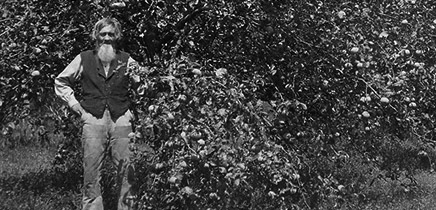Andrew Peterson was born Anders Petterson on October 20, 1818, on a farm in Sjoarp, Vastra Ryd, Ostergotland, Sweden. His family had financial ties to the church, so he and his brother received a better education than many farmers of the time. He had interests in music, and experimental agricultural and farm techniques.
In 1850, at thirty-two years old, Andrew Peterson immigrated to the United States, arriving in Boston on July 2. During his voyage, Peterson began keeping a daily journal. He would continue writing for the next forty-eight years, until two days before his death. Most of the early journals were unfortunately later lost. From Boston, he traveled west to Peru, Illinois, and then on to a settlement called New Sweden, near Burlington, Iowa. While in Iowa, Peterson “Americanized” his name, from Anders Petterson to Andrew Peterson.
In 1853, wanting to own land of his own rather than working for others, Peterson visited Minnesota where he filed a claim for a farm. Two years later, on May 4, 1855, Peterson left for Minnesota permanently with his sister and her family. He settled on his claim close to a community called Scandia, near Waconia. He began an orchard on his land, as well as farming more traditional crops. The farm was his by December 6, 1856. During these years, Peterson was a founder of the Scandia Baptist Church. Meetings were held in his home. A church building was erected not long after.
Peterson visited nearby King Oscar’s settlement, near the twenty-first century town of East Union, to buy more trees and grafts for his orchard. While there, he met a woman named Elsa. They married in 1858 when he was forty and she was twenty-three. They had nine children: Ida, George, John, Charles (Carl), Frank, Emma, Anna, Josephine and Oscar. He continued his daily diary, recording trips to town, work on the farm, visits with neighbors, and in 1862, his thoughts on the U.S.-Dakota conflict. His orchard was blossoming, with the farm producing apples, pears, plums, grapes, and cherries.
In 1874, Peterson joined the Patrons of Husbandry, a national fellowship of farmers. He sent apple grafts to growers as far away as Iowa. His experimental work was recognized at the January 1888 annual meeting of the Minnesota Horticultural Society. He received an honorary life membership, by unanimous vote.
At its height, his orchard produced over two hundred varieties of apples. Peterson hosted tours to leading experts in the field from nearby states and as far away as Ottawa, Canada. Later, his orchard became one of fifteen experimental fruit breeding research stations in Minnesota, run by the Minnesota Horticultural Society. His farm was located six miles from what would become the University of Minnesota Landscape Arboretum and Horticultural Research Center.
Peterson died on March 31, 1898. His wife Elsa Peterson ran the farm with her children until her death March 8, 1922. As their children died with no heirs, his last daughter Emma gave the farm to Sarah Peterson, a neighbor who had cared for Emma in her old age. The farm then passed into the hands of the Holasek family, who renamed it Rock Isle Farm.
The Andrew Peterson farmstead was placed on the National Register of Historic Places in 1978. His children donated Peterson’s diaries to the Minnesota Historical Society in the 1930s. Swedish novelist Wilhelm Moberg discovered them while visiting Minnesota for research in the 1940s. He used the journals as the basis of his four novels: The Emigrants, Unto a Good Land, the Settlers, and the Last Letter Home. A musical called Andrew Peterson: The Genuine Pioneer Story had great success in Sweden in 2012. In the twenty-first century, Carver County is sister counties with Ydre, Sweden, Peterson’s home county. The Carver County Historical Society restored the granary on the farmstead in 2006 with help from Swedish carpenters, and began restoration on the north barn in 2010.
Turning Point: In 1850, Andrew Peterson journeyed to America and began daily journals that would provide a unique glimpse into the life of a Swedish immigrant.
Chronology:
- October 20, 1818: Anders Petterson (Andrew Peterson) born in Sweden.
- 1850: Thirty-two year old Peterson travels by ship to America, landing in Boston on July 2.
- July-August, 1850: Peterson travels to Illinois and Iowa, where he settles in New Sweden, Iowa.
- 1853: Peterson visits Minnesota to file a claim for a farm.
- May 4, 1855: Peterson leaves for Minnesota permanently with his sister and her family.
- December 6, 1856: Peterson pays off his claim and owns his farm.
- 1858: Andrew Peterson marries a woman named Elsa from King Oscar’s settlement.
- 1874: Peterson joins the Patrons of Husbandry, a national fellowship of farmers.
- January 1888: Peterson is honored with a life membership from the Minnesota Horticultural Society for his experimental work.
- March 31, 1898: Andrew Peterson dies.
- March 8, 1922: Elsa Peterson dies.
- 1978: Historic Andrew Peterson Farmstead placed on National Register of Historic Places.
- 2006: Log granary on farmstead restored with help of Swedish carpenters.
- 2010: Work begins to restore north Peterson barn.
BIBLIOGRAPHY
Anderson, Keith. “The Swedish Connection.” Waconia Patriot, September 16, 2004.
RL 2001.3.1
Andrew Peterson Diaries, 1855-1898.
Manuscript Collection, Minnesota Historical Society, St. Paul
Description: English translation of diaries. Kept by Andrew Peterson for much of his life, detailing his daily activities.
“Andrew Peterson Farm Receives Grant.” Chanhassen Villager, February 2, 2012.
Andrew Peterson Sällskapet. http://www.andrewpeterson.se/index_eng.htm
“Awarded Several Premiums for Apples and Grapes.” Weekly Valley Herald, September 17, 1891.
“Chanhassen: 4 Swedish Men Arrive to Repair Granary Roof of Historic Farm in Scandia.” Carver County News, October 12, 2006.
“County Project Gets Historical Society Grant.” Carver County News, July 27, 1978.
“Died- Andrew Peterson, Pioneer of Laketown.” Carver County News, April 7, 1898.
“Excerpts from Andrew Peterson’s Journals.” Star Tribune, March 27, 2012. http://www.startribune.com/local/west/144019856.html
“Farm Stock, Home and Apples Shown.” Weekly Valley Herald, October 7, 1886.
“Historic Peterson Farm.” Norwood Times, August 10, 1978.
“Jan Hermelin: Meet the Real “Karl Oskar” of Moberg’s Emigrant Saga.” The Swedish-American Chambers of Commerce Currents Online, January 13, 2011. http://sacc-usa.org/currents/business/jan-hermelin-meet-the-real-karl-oskar-of-mobergs-emigrant-saga/
Mihelich, Josephine. Andrew Peterson and the Scandia Story. Minneapolis: Ford Johnson Graphics, 1984.
“Obituary- Mrs. Andrew Peterson.” Waconia Patriot, March 16, 1922.
Olson, Mark W. “Coming to America.” Chanhassen Villager, November 1, 2007.
Qualey, Carlton C. “Diary of a Swedish Immigrant Horticulturist,1855-1898.” Minnesota History, 43 No. 2 (Summer 1972): 63-70. http://collections.mnhs.org/MNHistoryMagazine/articles/43/v43i02p063-070.pdf
Salden, Jessica. “County Interested in Historic Peterson Farm.” Carver County News, October 26, 2006.
Westman, Tama. “Swedish Homesteader a Celebrity in Homeland.” Chanhassen Villager, March 17, 2005.
Zuege, Unsie. “Commissioner Visit Has Ties to County Pioneer.” Chanhassen Villager, June 11, 2009.
__________. “Commissioner Visits Homeland of Carver County Pioneer.” Chanhassen Villager, July 23, 2009.
__________. “The Swedes are Coming.” Chaska Herald, October 5, 2006.
__________. “Swedes Share Roots With Visitors.” Chaska Herald, October 26, 2006.
RELATED RESOURCES
Secondary:
Holcombe, Maj. R.I., ed. Compendium of History and Biography of Carver and Hennepin Counties, Minnesota. Henry Taylor and Company: Chicago, 1915.
Lofstrom, Ted and Lynne VanBrocklin Spaeth. Carver County: A Guide to Its Historic and Prehistoric Places. St. Paul: Minnesota Historical Society Press, 1978.
Moberg, Vilhelm. A History of the Swedish People: From Prehistory to the Renaissance. Translated by Paul Britten Austin. New York: Pantheon Books, 1971.
Petersen-Biorn, Wendy. “Preserving a (Inter)National Treasure: the Andrew Petersen Farm.” Powerpoint presentation. Carver County Historical Society, 2012.
Tremblay, Ruth and Lois Schulstad. Images of America: Carver County. Charleston, S.C.: Arcadia Publishing, 2011.
Waconia Heritage Association. Waconia, Paradise of the Northwest: The Lake and Its Island. Dallas:
Taylor Publishing Company, 1986.
Web:
American Swedish Institute website. http://www.asimn.org/
The Swedish Emigrant Institute. http://www.utvandrarnashus.se/eng/
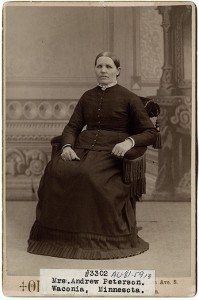
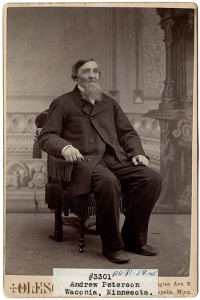
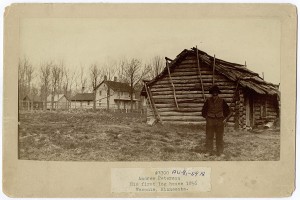
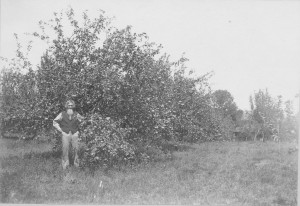
“This article used with the permission of MNopedia, operated by the Minnesota Historical Society, under a Creative Commons License. No changes have been made to the article’s content.”

